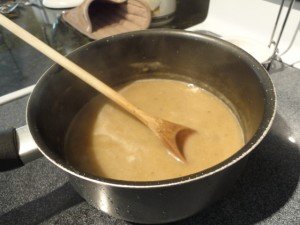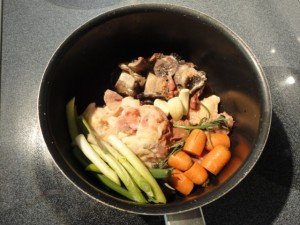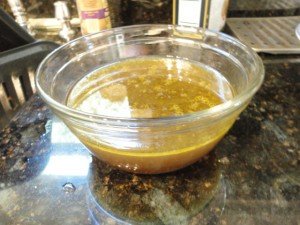Giblets are the polite culinary term for the organ meat, also known as offal for poultry (chicken, turkey, goose, duck…you get the idea). Giblets typically include the heart, liver, gizzards and the neck. Yes, the neck is not an organ, but in the United States, the neck is typically included in with the Giblets. The word giblet comes from Old French via Middle English and means “game stew”
For those at this point have gone squeamish, saying “yuck” and about to close the post, read on. Giblet gravy is phenomenal and there is no comparison. Not to mention the idea of handling and cooking giblets may make you shudder, but trust me, you have eaten giblets whether you have realized it or not.
Giblets can be sourced two different ways. The first is when purchasing a whole bird (poultry). The plastic wrapping will indicate that there are partial giblets or whole giblets enclosed within the cavity of the bird, either in loose form or in a packet. I am confident that some of readers have not removed the giblets prior to roasting the bird in the past. Regardless, the giblets need to be removed before preparing the bird for roasting. The second source of giblets is to purchase the giblets in individual containers from the grocery store. Most grocery stores sell chicken livers and gizzards in this manner. Hearts are not as easy to find and the neck are typically packaged and sold frozen. More often then not, you will have difficulty in finding chicken necks, but turkey necks are a fine substitute.
I could go into great detail on what makes Giblet Gravy so amazing, that the organ meat provides a deep, rich, earthy (iron) complexity to the gravy for which there is no substitute. This description is bordering on being a “Foodie” and this blog is all about the fact that “We are not Foodies”.
When I first made Giblet Gravy years ago for Thanksgiving Dinner it was at the insistence of my mother. I had no idea what I was doing and followed her instructions. In time I have expanded upon her timeless recipe and have created what I believe is to be freestyle approach that takes advantage of whatever is available in the refrigerator.
Where appropriate in this post, I have explained that an ingredient is optional. Much of what I add to the stock that first must be prepared is based upon what I have been saving in the freezer in the event that I want to make a stock for a soup or a gravy.
Making the Giblet Gravy Stock
- Medium size sauce pan (3 Quart)
- Giblets from the bird, washed and if desired sliced, cut or scored to expand their surface area
- Chicken trimmings (meat and fat) that I have been saving in the freezer from the preparation of previous meals: Baked Breaded Chicken Cutlets and Asian Style Orange Chicken. (Optional)
- Mushroom Stems and broth from the snacks that I prepared in the following two dishes: Broiled Portabella with Blue Cheese and Open Faced Boiled Swiss Cheese, Ham and Portabella. (Optional)
- The tops of the carrots that I cleaned to be used as a side dish with the roasted chicken. Note: Vegetable tops are a great source of flavor and a perfect use of something that otherwise was going to be discarded. At Thanksgiving I always roast carrots, parsnips, celery and mushrooms to go with the turkey. I throw all of the tops into the giblet stock.
- Three to four garlic cloves. I just smash them with the broad side of the knife and toss them in. I do not peel them first.
- Two or three Bay Leaves
- Pinch of Salt (I prefer to use Sea Salt)
- A dozen or so cranks on the Black Pepper Mill
- Dash of Herbs (Rosemary, Thyme, Herbs de Provence), or use a fresh sprig of the first two
- Everything but the Kitchen Sink: There is typically some vegetable in the refrigerator that you had used for a previous meal and is looking a little ragged. I almost always add these tired looking vegetables to the stock. This time it was green onions, but in the past it has been onions, shallots, celery, mushrooms or parsnips. I would caution using Bell Peppers for they may impart too much flavor.
- Once all of the ingredients have been added, fill the sauce pan 7/8ths full with water and turn on the stove to High and bring it to a boil. Once it has begun to boil, bring slowly reduce the heat to Medium Low. The key is two-fold. First is to extract all of the flavor and essence from the ingredients. The second is that you want to reduce the volume of liquid in order to concentrate the flavors. In short, you are making a chicken stock.
- About an hour or so later, the volume in the sauce pan has been reduced 50%. Turn off the heat and allow the giblet stock to cool.
- Place a wire strainer over a bowl and pour the contents of the saucepan into the wire strainer to separate the ingredients from the liquid. You should have strained about 4 – 5 Cups lof liquid / stock.
Making the Gravy
- Separate the fat (drippings) from the stock. Add the drippings from the chicken (poultry) the same sauce pan and heat on Medium High. If you do not have the drippings from the roasted chicken, then use two to three tablespoons of butter.
- Add three table spoons of flour
- Mix these two ingredients well. For those that did not know, you just created a rue.
- Slowly add the Giblet Stock to the rue, thoroughly mixing the two together. It may appear to be a little thin at first, but it will thicken to the right consistency.
- Add Salt and Black Pepper to taste. If done right, no additional seasoning is required.
- Once the gravy has come to a boil, reduce the heat to Low until you are ready to serve the Giblet Gravy with the roasted chicken. Since the roasted chicken has to be out of the oven and resting for twenty minutes and use of the drippings are an essential element to the gravy, I make my gravy during the time when the bird is resting prior to being carved.
Leftover Gravy:
There will likely be some leftover giblet gravy remaining at the end of meal if prepared with a roasted chicken or turkey. There are a couple of uses for this gravy. You can use it with the leftovers for your next meal to moisten the meat, as the wet ingredient in a homemade potpie with the leftover meat or freeze it in the freezer and use it for another meal where poultry is the meat, but no gravy was created; i.e. baked chicken breasts or thighs. I have even added it to soup since the remaining amount will not affect the overall consistency of a soup.







1 comments
Leftovers? Not with this gravy!